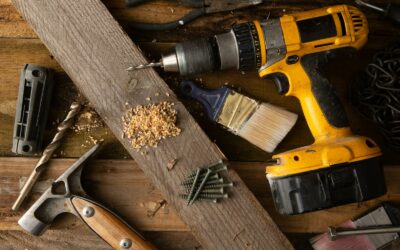
Construction projects are the backbone of real estate development, yet every towering skyscraper, state-of-the-art hospital, or boutique apartment complex begins with a foundation built by essential workers—construction laborers. These skilled individuals, often working behind the scenes, are integral to the success of every project, blending craftsmanship, precision, and physical labor.
This blog will explore the evolving world of construction labor, highlight the pivotal role of construction laborers, and discuss how industry leaders like South Coast Improvement Company are reshaping labor practices through innovative, client-focused approaches such as their Design-Build Service Package.
The Evolution of Construction Labor
Construction labor is an ancient profession, dating back thousands of years. Early civilizations used manual tools made of stone, bronze, or iron to erect structures like the Pyramids of Giza and the Roman Aqueducts. Back then, labor depended heavily on manual effort, without the convenience of powered cement mixers or air hammers.
Today, modern advancements and technology have revolutionized the field. Tools such as laser guidance equipment, small mechanical hoists, and powered cement finishing tools allow laborers to maintain precision and efficiency. Additionally, the use of measuring equipment in modern construction ensures that areas are measured and marked accurately, which is crucial for tasks like laying out foundations and installing structural components. Furthermore, trends such as green-certified construction practices and automated equipment are making projects more sustainable while ensuring better outcomes.
Innovations have also shaped safety standards and waste management procedures. Unlike earlier times, construction laborers now follow strict regulations to maintain air monitoring in confined or hazardous environments, manage outdated materials effectively, and operate mechanical tools with rigorous safety training.

The Role of a Construction Laborer
Construction laborers are the heart and hands of any building project. They perform tasks involving physical labor to ensure projects are executed smoothly. Often, they load or unload materials to specific locations where they are needed. Here’s an overview of their key responsibilities:
Prepare Construction Sites
Construction laborers work to prepare construction sites for building activity, ensuring safety and readiness for work activities. This involves clearing other waste materials, digging trenches, positioning construction forms, and setting up other temporary structures like scaffolding and masonry supports.
Operating Hand and Power Tools and Equipment
Operating hand and power tools, such as air hammers, hand or caulking guns, and portable cement mixers, is another critical responsibility. Construction laborers may also take on the role of ‘equipment operator’ to handle machinery essential for construction tasks. They also handle machinery such as small mechanical hoists, pipe-laying machinery, and drop crew laborer equipment.
Assisting Skilled Workers
Laborers support other craft workers by providing tools, helping with assembly, and facilitating alignment for structural components. Construction laborers often signal equipment operators to ensure the proper alignment and positioning of machinery on-site. Whether assisting a scaffolding operator or helping install green structural components, their contribution ensures the construction process flows seamlessly.
Maintaining Construction Tools and Safety
Laborers are responsible for maintaining construction tools, testing air quality in hazardous areas, and repairing machinery to keep projects up and running. Furthermore, they implement safety equipment to protect themselves and the structures they build.
Erecting and Finishing Structures
Laborers position essential building materials, compact and level earth, finish freshly poured cement, and seal structural components, ensuring each construction project is completed on time and within specifications.

Work Environment of Construction Laborers
Construction laborers work in a variety of settings, each presenting unique challenges and demands. Whether on bustling construction sites, within the confines of buildings, or at other locations, these professionals must be prepared for a range of conditions. They often work outdoors, exposed to the elements, including extreme heat, cold, and rain. This exposure requires them to be resilient and adaptable, ready to face whatever the weather throws their way.
The physical demands of the job are significant. Construction laborers frequently lift, carry, and move heavy materials and equipment, requiring not only strength but also stamina. The work environment can also be hazardous, with potential exposure to dangerous materials and equipment. Therefore, safety precautions are paramount to prevent injuries, and laborers must be vigilant and well-trained in safety protocols.
Laborers may find themselves working on a variety of projects, from residential homes and commercial buildings to industrial facilities and infrastructure projects like roads and bridges. Each project type brings its own set of tasks and challenges, whether it’s new construction, renovation, or repair work. The pace is often fast and dynamic, with multiple tasks and projects running concurrently. This requires laborers to be able to work well under pressure, adapt to changing circumstances, and prioritize tasks effectively.
Skills and Qualifications Required
To excel as a construction laborer, a diverse set of skills and qualifications is essential. Physical strength and endurance are fundamental, as the job involves extensive manual labor. Laborers must be adept at operating a variety of hand and power tools, including air hammers, earth tampers, and cement mixers. This technical proficiency ensures they can perform their tasks efficiently and safely.
A solid understanding of construction techniques and methods is also crucial. Laborers need to be able to read and interpret plans and specifications accurately, ensuring that the work aligns with the project’s requirements. Safety is a top priority, so a thorough knowledge of safety protocols and the ability to work safely is non-negotiable.
Teamwork is another critical aspect of the role. Construction laborers often work closely with other craft workers and must be able to communicate effectively and solve problems collaboratively. Good communication skills help in coordinating tasks and ensuring that everyone is on the same page.
Adaptability is key in the ever-changing environment of construction sites. Laborers must be able to adjust to new priorities and circumstances as they arise. Additionally, specialized training or certifications, such as OSHA certification or training in green certified construction practices, can enhance a laborer’s qualifications and open up more opportunities within the field.
By possessing these skills and qualifications, construction laborers can contribute significantly to the success of any construction project, ensuring that it is completed safely, efficiently, and to the highest standards.

South Coast Improvement Company’s Approach to Construction Labor
South Coast Improvement Company takes construction labor to the next level by combining professional expertise with innovative solutions. They understand that successful construction isn’t just about putting up walls—it’s about fulfilling client needs in a precise and timely manner.
Their unique Design-Build Service Package serves as a one-stop solution, ensuring collaboration between architects, engineers, and construction teams from inception through completion. This eliminates communication gaps, reduces unforeseen costs, and accelerates project timelines.
What Makes South Coast Improvement Stand Out?
- Single-Source Accountability: South Coast acts as the single point of contact for both design and construction. This simplifies client communication and ensures aligned goals at every stage.
- Cutting-Edge Planning: By identifying long-lead items and refining schedules, South Coast prevents delays and optimizes resource allocation.
- Sustainability Focus: The company is committed to green certified construction practices, which include implementing waste management procedures and installing eco-friendly structural components.
- Client-Centric Approach: They deliver solutions tailored to the unique requirements of each project, be it a residential facility or commercial property.
The Significance of Design-Build in Modern Construction
Traditional construction models often separate design and building teams, leading to miscommunication and inefficiency. The Design-Build approach, by contrast, represents a streamlined “single-source” model where one team oversees the entire project. This ensures efficiency, transparency, and accountability.
Benefits of the Design-Build Method
- Time Efficiency: Simultaneous design and construction reduce overall project timelines compared to the traditional linear approach.
- Cost Savings: Accountable teams and open communication help identify potential cost overruns early, saving money.
- Improved Collaboration: Teams work together from the project’s inception, optimizing creative input and execution.
Case Study Success Stories
South Coast Improvement Company has a track record of success with the Design-Build approach:
- Residence at Great Woods: Delivered an award-winning residential project, seamlessly balancing design and construction.
- Fresenius Kidney Care: Completed a $1.6M medical facility project on time and within the client’s budget.
These outcomes demonstrate the power of Design-Build in achieving client satisfaction while maintaining high standards.
Why Construction Laborers Matter
Construction laborers are more than just a cog in the development machine—they are the essence of every successful project. From preparing sites and managing equipment operators to concluding with polished structural components, their role is fundamental in bringing architectural visions to life.
With companies such as South Coast Improvement Company leading the way, construction labor is evolving to meet modern demands. Their client-focused Design-Build services ensure that each project benefits from seamless coordination and measurable results while adhering to sustainable practices.

Partner with South Coast Improvement for Your Next Project
Are you planning a development project? Partner with South Coast Improvement Company to experience the benefits of construction labor expertise paired with cutting-edge design-build services. Transform your vision into reality while optimizing costs, timelines, and outcomes.
Get in touch today to explore how our services can align with your unique goals and requirements.
Resources
Here are some valuable resources to support your development project:
- Construction Industry Institute: A research organization dedicated to improving the effectiveness and sustainability of the construction industry.
- U.S. Green Building Council: A leading authority on sustainable building practices and certification programs, such as LEED.
- Construction Dive: An online publication providing news, insights, and analysis on the latest trends and developments in the construction industry.
- National Association of Home Builders: A trade association representing the interests of the housing industry, offering resources and expertise on residential construction.
- Project Management Institute: A globally recognized organization providing project management standards, certifications, and resources.
- Associated General Contractors of America: A leading trade association representing the commercial construction industry, advocating for construction professionals and offering resources and industry insights.
- American Society of Civil Engineers: A professional organization dedicated to advancing the civil engineering profession and promoting sustainable infrastructure development through research, education, and industry collaboration.
- Construction Financial Management Association: An association focused on providing financial management and accounting resources tailored to the construction industry, helping professionals navigate financial challenges and ensure business success.
- Design-Build Institute of America: An organization promoting the use of design-build project delivery method, offering education, certification, and advocacy to industry professionals and promoting collaboration and efficiency in construction projects.
- International Facility Management Association: An association supporting facility management professionals with resources, education, and networking opportunities to optimize the management of built environments and enhance operational efficiency.
- American Institute of Architects: A professional organization empowering architects and design professionals, advocating for the value of architecture, and providing resources for design excellence, sustainability, and community engagement.
These resources can provide valuable guidance, insights, and best practices to support you throughout your project.
View Our Work
Brandywine Haverford Estates by Monarch
South Coast Improvement Company has completed interior renovations at the senior living community, Brandywine Haverford Estates by Monarch. We were entrusted with enhancing the facilities, and the results speak for themselves. The team brought diligence and...
Nouveau Marc by Barclay House
South Coast Improvement Company proudly partnering with QSL Management delivered a comprehensive renovation at Nouveau Marc by Barclay House, a premier senior living community. This project focused on revitalizing key resident areas with an emphasis on safety,...







